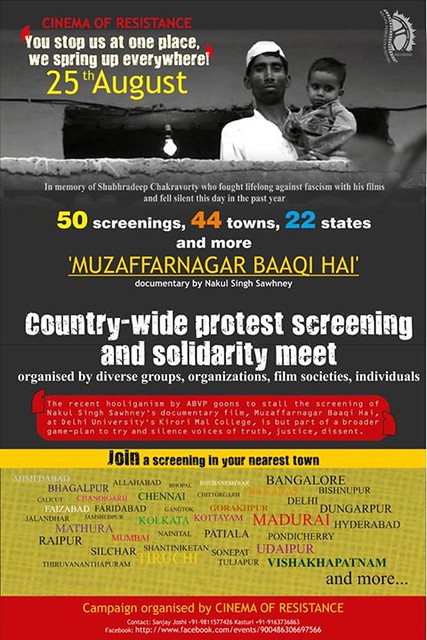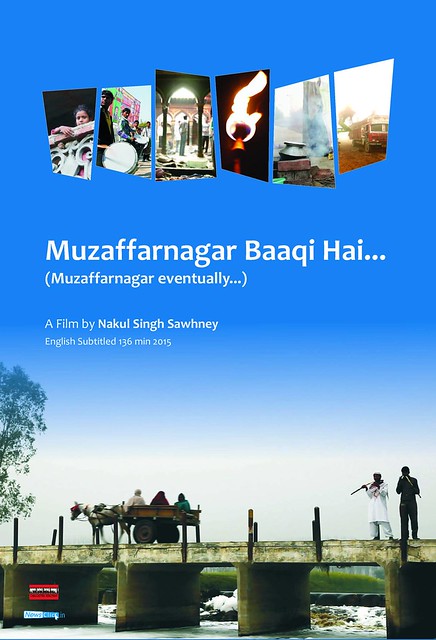By TwoCircles.net Staff Reporter,
New Delhi: On the initiative of ‘Cinema of Resistance’, a documentary on Mzuaffarnagar riots was screened countrywide on at least 60 different venues across 50 cities on August 25 as mark of protest against attempts by Hindutva groups to halt its screening at the University of Delhi and later at JNU.

“The recent hooliganism by ABVP goons to stall the screening of Nakul Singh Sawhney’s documentary film, Muzaffarnagar Baaqi Hai, at Delhi University’s Kirori Mal College, is but part of a broader game-plan to try and silence voices of truth, justice, dissent,” the organisers noted at its Facebook page.
On August 1, members of right wing students’ body Akhil Bharaitya Vidyarthi Parishad (ABVP) stalled the screening of ‘Muzaffarnagar Baaqi Hai…’ (Muzaffarnagar Eventually), over two hours long documentary film about the anti-Muslim massacre that broke out in September, 2013 in Muzaffarnagar and Shamli districts of Western Uttar Pradesh. The film is directed by award winning film maker Nakul Singh Sawhney. There were later attempts to hat its screening at Jawaharlal Nehru University as well.
The organisers sent the DVD of the film free of cost to those who wanted to screen the film. Large turnout has been reported from most places. The screening at Mumbai’s The Hive was already cancelled after police intervention.
At the time of filing this report, there were reports from at least two places where screening had to be stopped midway due to police interference. At Space in Chennai, police did not let the screening continue after which there were protests by the audience, most of whom rushed to the Max Muller Bhavan to immediately organise the private screening. At Shanti Niketan too police stopped the screening midway. Interestingly both these places are in non-BJP ruled states. There were no reports of any untoward incident at any place such.
Speaking to TwoCircles.net, film-maker Sawhney said that he is overwhelmed at the response of the people in standing up against the attempt of the government and the ruling party to silence the voice of dissent. Considering that more than 7000 people watched the documentary on a single day, he agreed that in a way the obstruction provided them an opportunity to reach out to the larger audience and spreading the message through his film.
Considering the response across the country, surely attempts of thwarting the alternative voice has met with stiff resistance. It should be mentioned here that film-maker Sawhney is an alumnus of an of the Pune based Film and Television Institute of India (FTII) that has been in news past few weeks for its continuous two months strike against the appointment of Gajendra Chouhan as the FTII Director.
Sawhney also informed that today was the beginning for this screening as protest that will continue for days to come at several locations across the country.

The day chose for the screening of the film is significant, for on August 25 last year, noted documentary film maker and freelance journalist Shubhradeep Chakravorty passed away, who throughout his filmmaking life stood up against fascist forces and dared saffron terror. His made films like Godhra Tak: The Terror Trail, Encountered on Saffron Agenda?, Out of Court Settlement, After the Storm, etc. His last film too was on the Muzaffarnagar violence, titled En Dino Muzaffarnagar, which was not cleared by censor board for public screening.
His family and friends claimed that Shubhradeep had been very depressed because the CBFC did not pass his film and that he had the brain haemorrhage due to pressure and depression that caused his death.
The countrywide screening of the film was dedicated to Shubhradeep Chakravorty The film was screened in most of the tier one and tier two cities and towns.
In September, 2013, Muzaffarnagar and Shamli districts of Western Uttar Pradesh, witnessed their worst ever anti-Muslim pogrom since Indian Independence. More than 100 people were killed and close to 80,000 people were displaced.
‘Muzaffarnagar Baaqi Hai…’ (Muzaffarnagar eventually…) explores as to why a relatively harmonious hinterland erupted into communal rioting in 2013, examining the many facets of the massacre- the question of women’s ‘honour’, which was used by organisations of the Hindu right, including BJP-RSS, to orchestrate communal violence, the merging of caste identity politics within the larger Hindutva fold, the breakdown of the once powerful farmers’ union, the Bhartiya Kissan Union, whose survival hinged on the unity of Hindu and Muslim peasants, the various aspects of Dalit politics in the districts, the dubious role of the Samajwadi Party, the ruling party in Uttar Pradesh and the feeling of complete alienation and marginalisation of the Muslim community.
The film looks at how the massacre found its resonance in the 2014 Indian General Election campaign. Finally, it tells of the continued and growing resistance in Muzaffarnagar and Shamli districts against the corporate- communal nexus.

